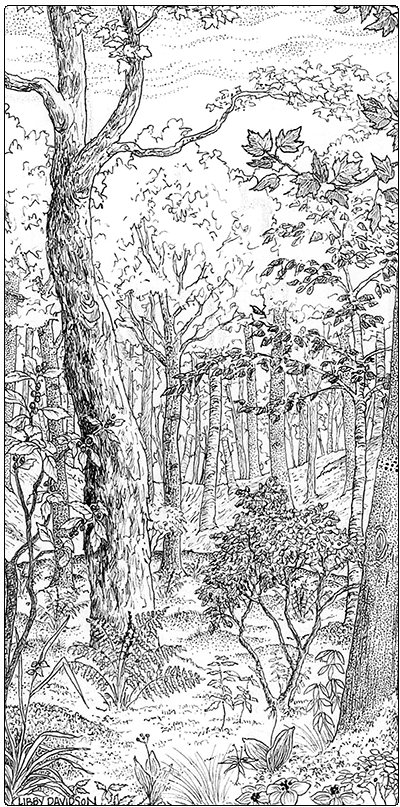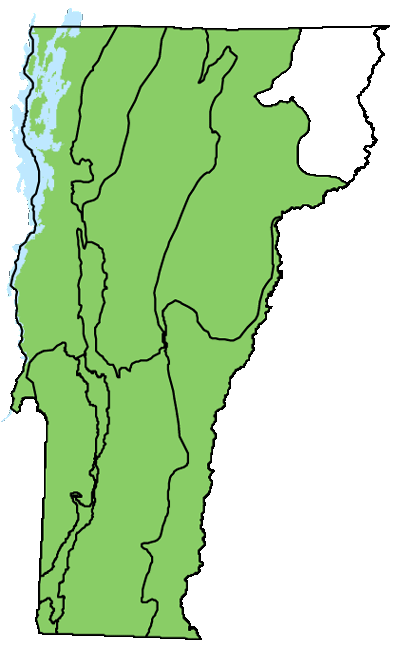Ecology and Physical Setting
Red Maple-Sphagnum Basin Swamps occur in small basins ringed by upland forested hillsides. With their mossy carpets and spongy ground, they are a welcome diversion from the surrounding dry woods.
Most of these swamps are smaller than 15 acres, and many are less than two acres. Their watersheds are small, with most covering less than 100 acres, and some as small as 10 acres. Surface runoff provides the primary source of water in these swamps. Swamps with small watersheds often lack standing water in their margins, and outlet streams are seasonal or absent. Swamps with larger watersheds are likely to have very wet margins and distinct outlet streams. A few examples of this community type occur within larger wetland complexes, but in these cases, the swamp surface is raised, so the Red Maple-Sphagnum Basin Swamp is above the influence of flooding.
These swamps have deep, peaty organic soils that are permanently saturated. Soils are acidic and low in dissolved minerals, but the environment is not nearly as harsh as that of an open bog. While groundwater only minimally influences these swamps, surface water runoff can enrich the wet margins. Well-developed hummocks alternate with hollows that generally lack standing water. Moss is ubiquitous, carpeting both hummocks and hollows.
Vegetation
Red Maple-Sphagnum Basin Swamps are relatively simple floristically, with many fewer species than seepage swamps. Red maple dominates the tree canopy. White pine is a common associate, with tall trees often emerging above the red maple. Yellow birch, hemlock, and red spruce are commonly present in low abundance. The shrub layer—especially the tall shrub layer—is well developed, and includes mountain holly, winterberry holly, highbush blueberry, and wild raisin. Low shrubs include black chokeberry, low sweet blueberry, swamp dewberry, and speckled alder. Heath shrubs typical of more boggy wetlands, including sheep laurel, leatherleaf, and Labrador tea, are present in some swamps.
Herbaceous cover is typically high, with cinnamon fern usually a strong dominant. Three-seeded sedge, long sedge, royal fern, marsh fern, and northern bugleweed can all be frequent. Hummocks support upland species such as Canada mayflower, sarsaparilla, and the boreal herbs goldthread, starflower, bunchberry, and bluebead lily. Indicators of groundwater enrichment are mostly absent, or are restricted to the margins of the swamp where there is more mineral soil contact.

with dense cinnamon fern and an open overstory.
Sphagnum covers the hummocks and hollows. Common hummock species include Sphagnum centrale, Sphagnum magellanicum, and Sphagnum palustre. On low hummocks and moist hollows Sphagnum angustifolium, Sphagnum girgensohnii, and Sphagnum fimbriatum are all common. Other bryophytes include Pleurozium schreberi and Bazzania trilobata.
Wildlife Habitat
The saturated sphagnum floors of these swamps provide ideal habitat for the rare four-toed salamander. These slender amphibians construct nests within the upper layers of the moss, where the female turns upside-down and attaches eggs individually to the underside of moss branches and fine roots. The rare blue-spotted salamander is also found in these swamps and other low-elevation wetlands of Vermont. Several species of birds, including great-crested flycatcher, winter wren, northern waterthrush, and veery, are likely to breed in these small swamps.
Related Communities
- Red Maple-Black Ash Seepage Swamp has red maple and black ash as canopy co-dominants. Species richness is high due to mineral-rich groundwater seepage. Seeps are abundant at the swamp margins, and perennial streams flow out.
- Hemlock-Sphagnum Basin Swamp is dominated by hemlock in a closed canopy, with red maple and yellow birch as common associates. Shrubs and herbs are similar but are less abundant due to the dense conifer canopy. Sphagnum dominates the swamp floor.
Conservation Status and Management Considerations
These small swamps are uncommon in the Vermont landscape, and they occupy a very small total area. We recommend no timber harvesting in these swamps. The hydrology of a Red Maple-Sphagnum Basin Swamp is strongly influenced by its surrounding small watershed. Protecting the hydrology of the swamp necessitates moderating surface water runoff, and maintaining forest cover, abundant large fallen trees, and intact soil structure within the watershed.
Distribution/Abundance
Red Maple-Sphagnum Basin Swamps are uncommon but likely occur in all biophysical regions except the Northeastern Highlands. Similar communities are known from Pennsylvania and New Jersey north to New Brunswick
Characteristic Plants
Trees
Abundant Species
Red maple – Acer rubrum
Occasional to Locally Abundant Species
White pine – Pinus strobus
Yellow birch – Betula alleghaniensis
Eastern hemlock – Tsuga canadensis
Red spruce – Picea rubens
Shrubs
Occasional to Locally Abundant Species
Mountain holly – Ilex mucronata
Winterberry holly – Ilex verticillata
Highbush blueberry – Vaccinium corymbosum
Wild raisin – Viburnum nudum var. cassinoides
Black chokeberry – Aronia melanocarpa
Speckled alder – Alnus incana
Arrowwood – Viburnum dentatum
Sheep laurel – Kalmia angustifolia
Leatherleaf – Chamaedaphne calyculata
Labrador tea – Rhododendron groenlandicum
Low sweet blueberry – Vaccinium angustifolium
Swamp dewberry – Rubus hispidus
Herbs
Abundant Species
Cinnamon fern – Osmundastrum cinnamomeum
Occasional to Locally Abundant Species
Three-seeded sedge – Carex trisperma
Long sedge – Carex folliculata
Royal fern – Osmunda regalis
Marsh fern – Thelypteris palustris
Goldthread – Coptis trifolia
Bluebead lily – Clintonia borealis
Bunchberry – Cornus canadensis
Starflower – Lysimachia borealis
Canada mayflower – Maianthemum canadense
Sarsaparilla – Aralia nudicaulis
Northern bugleweed – Lycopus uniflorus
Bryophytes
Moss – Sphagnum centrale
Moss – Sphagnum magellanicum
Moss – Sphagnum palustre
Moss – Sphagnum angustifolium
Moss – Sphagnum girgensohnii
Moss – Sphagnum fimbriatum
Schreber’s moss – Pleurozium schreberi
Three-lobed bazzania – Bazzania trilobata
Rare and Uncommon Plants
Green adder’s mouth – Malaxis unifolia
Floating mannagrass – Glyceria septentrionalis
Associated Animals
Great crested flycatcher – Myiarchus crinitus
Winter wren – Troglodytes hiemalis
Northern waterthrush – Parkesia noveboracensis
Veery – Catharus fuscescens
Rare and Uncommon Animals
Four-toed salamander – Hemidactylium scutatum
Blue-spotted salamander – Ambystoma laterale
Places to Visit
Alburgh Dunes State Park, Alburgh, Vermont Department of Forests, Parks, and Recreation (VDFPR)
Worcester Woods Wildlife Management Area, Worcester, Vermont Fish and Wildlife Department (VFWD)
High Pond Natural Area, Sudbury, The Nature Conservancy
Pond Woods Wildlife Management Area, Benson and Orwell, VFWD
Okemo State Forest, Ludlow, VDFPR
